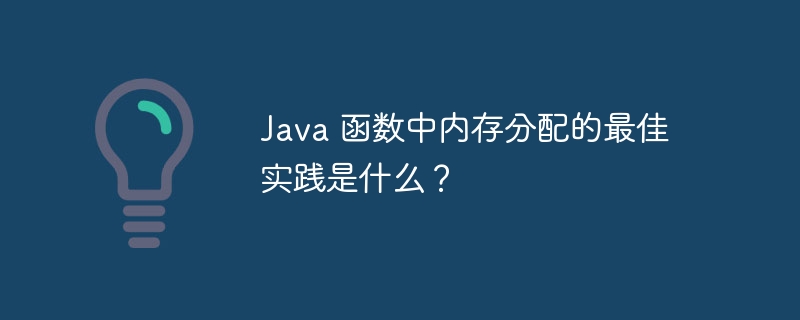
Best practices for memory allocation in Java functions include: using automatic memory management and ensuring that appropriate GC algorithms are used. Monitor memory allocation patterns and identify memory leaks or bottlenecks. Use object pooling to reuse objects of similar size. Avoid large numbers of short-lived allocations and consider using alternatives. Use the Null Object pattern to avoid creating unnecessary objects. Explicitly freeing native resources ensures that memory that is inaccessible to the Java GC is released.

Best Practices for Memory Allocation in Java Functions
Optimizing memory allocation in Java applications is crucial because it Can improve performance and prevent memory leaks. Here are some best practices for memory allocation in Java functions:
Use automatic memory management
Java uses garbage collection (GC) to automatically manage memory, so you usually do not have to manually allocate or Free up memory. Make sure to use the appropriate GC algorithm (such as CMS or G1).
Understand Memory Allocation Patterns
Monitor your application's memory allocation patterns to identify potential memory leaks or bottlenecks. Use Java auxiliary tools such as JVisualVM or JProfiler to analyze memory usage.
Appropriately sized object pool
If you frequently allocate objects of similar size, you can create an object pool to reuse these objects. This reduces memory allocation and garbage collection overhead.
Avoid a large number of short-lived allocations
Frequently allocating and releasing a large number of short-lived objects will increase GC pressure. Consider using alternatives such as memory pools or temporary variables.
Use Null Object Pattern
If you need an object but don't need it in some circumstances, use Null Object pattern. This avoids the creation of unnecessary objects, thus reducing memory allocation.
Explicitly Release Resources
If you hold native resources (such as file handles or database connections), be sure to explicitly release those resources when they are no longer needed. This will free up memory that is inaccessible to the Java GC.
Practical Case: Object Pool
Suppose we have a function that creates a new Foo object that contains a large amount of data. We can create an object pool to reuse these Foo objects as shown below:
import java.util.concurrent.ConcurrentHashMap;
public class ObjectPool {
private static final int MAX_SIZE = 100;
private ConcurrentHashMap<Integer, Foo> pool = new ConcurrentHashMap<>();
public Foo getFoo() {
Foo foo = pool.remove(fooId);
if (foo == null) {
foo = new Foo();
}
return foo;
}
public void release(Foo foo) {
if (pool.size() < MAX_SIZE) {
pool.put(fooId, foo);
}
}
} By using object pool, we can reuse Foo objects and reduce allocation and garbage Recycling overhead.
The above is the detailed content of What are the best practices for memory allocation in Java functions?. For more information, please follow other related articles on the PHP Chinese website!
